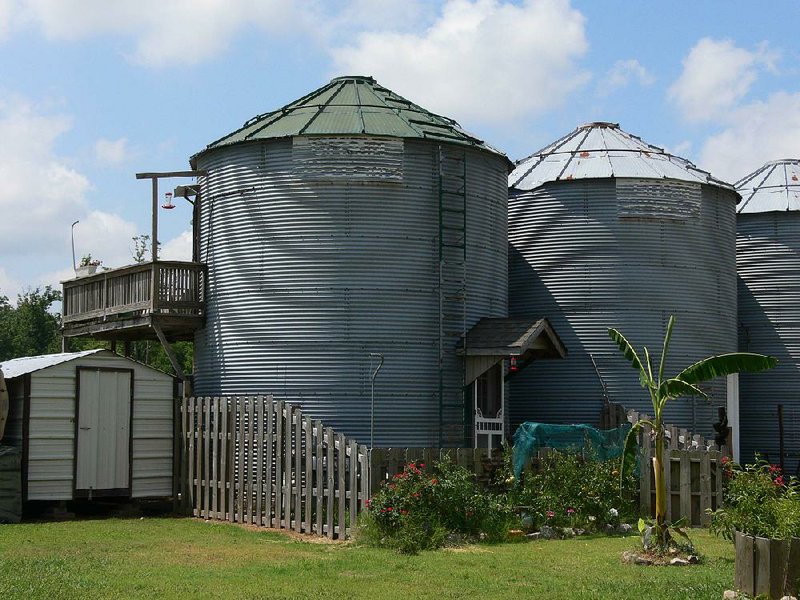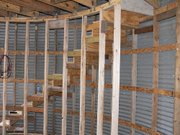The appeal of micro apartments is not restricted to Manhattan and Tokyo. One Lonoke County entrepreneur is offering something similar by converting small, unused grain bins into comfortable housing that is economical and environmentally friendly.
Though they are surrounded by scenic countryside and not high rises, the tiny Lonoke area apartments use many of the space-saving ideas incorporated in big-city condos to make living easy and efficient, especially for couples and singles.
In 2008 Kyle Butler, owner of Kyle’s Electric, bought a large farm building on three acres in southern Lonoke County near Toltec Mounds Archeological State Park to use as a shop for his electrical business. The property held four obsolete grain bins that had not been used for several years. The motors for moving grain and the heaters for drying it were not working. Butler recycled the motors, salvaged the wiring and sold the machinery as scrap metal.
He tried to rent the bins as storage units, but the narrow doors and high thresholds did not make them user friendly. In the end, he used the structures for storing light fixtures, used appliances and building materials.
ENVIRONMENTAL MATTERS
At today’s price for scrap iron, about 9 cents a pound or $180 a ton, the labor cost of tearing down bins makes hauling the metal to a salvage yard a losing proposition. Butler hit on the idea of converting the bins into offices or rental apartments.
His idea was not original, but it is a concept that has not been widely capitalized upon. The Internet provides several examples of projects that involve refurbishing grain bins into housing, cafes, offices and even churches, but the concept of doing so doesn’t seem to have caught on.
See tinyurl.com/letzt6j for examples and a discussion of people’s experiences with living in grain bin structures. Houses and apartments fashioned out of boxcars, cabooses and lighthouses are similar novelties, but grain bins are more common in Arkansas.
Given the number of abandoned silos that are rusting away in Arkansas, it is an idea that could yield benefits to apartment dwellers,farmers, real estate brokers and builders. It is not known how many bins exist, but they dot Pulaski, Lonoke and Jefferson counties. Farm owner Dr. Kent Westbrook reported that there are seven grain bins on his 3,000-acre farm near Galloway just north of Interstate 40. Dusky Hoskins, who farms 4,000 acres in Lonoke and Prairie counties, has six obsolete bins. Neither Westbrook nor Hoskins plan converting their bins into housing.
In an imaginative feasibility experiment, Utah Bates, who operates a small construction company that does light remodeling, builds boat docks and decks, undertook converting one of Butler’s grain bins into an office-apartment. In exchange for the right to live there for a while, Bates put in doors, added a second level, a staircase and an upstairs outdoor deck and worked on insulation and plumbing. He fenced a small yard and put in a patio garden along the sidewalk. Then he moved in.
Bates, a single man, has been living in the apartment 3 ½ years. “What I like best about my apartment is that I fixed it just for me. I’m out here and nobody bothers me and I don’t bother anybody. What I like least is the stairs, especially since I’ve had knee surgery.”
Butler will incorporate Bates’ experience to modify his design for the adjacent bins. Bates says, “The two skylights in my apartment and the windows made into the doors give me plenty of light, in fact too much light in the mornings, but I can’t see out very well. I wish I had a window to look out back over the bayou; it’s so pretty out there. I’ve put a shade over the skylight on the east side. Kyle is planning to add a window to the units he’s building.”
Butler is converting two bins into small apartments. The fourth will continue to be used as storage. Each unit will have about 500 square feet of living space (256 square feet on each level). The kitchen and living area will be downstairs. The upstairs is much more than a sleeping loft but the circular staircase gives it a loft-like feel. The upstairs accommodates a full bath and bedroom.
COST MATTERS
Tube-type skylights on the openings where soybeans and rice were once poured into the bins will save on lighting bills. One skylight in each bin will shine through the stairwell opening to illuminate upstairs and down. When the sun is not shining, LED lighting will reduce electrical consumption. A high efficiency heat pump will warm and cool the apartments. Three and a half inches of cellulose insulation in the walls and 8 inches in a vaulted attic will make heating and cooling economical. Bates’ electrical bill has averaged about $65 a month.
Converting grain bins into living space can be much cheaper and more environmentally friendly than new construction. The main cost savings come from the fact that the foundation, exterior and roof of the structure already exist. The major expense is for inside framing and interior finishing. The cost of interior work is slightly higher than traditional construction. Because carpenters and other tradesmen are accustomed to working with square rather than circular walls, measuring and cutting is more time consuming.
One Internet site suggests that grain bins would typically be torn down, moved to new locations and reconstructed.See tinyurl.com/kak998s. This can be done but the cost would add considerably to the expense and time requirements. Butler’s plan calls for the bins to remain in place. The four bins will eventually function as a single four-plex apartment building.
Drawing from Bates’ experience, Butler is on track to complete the renovation of the bins into apartments for about $10,000 each. He has already installed a septic system and electrical services for all four. Butler and his two sons are doing much of the labor and he has asked employees from his electrical business, as they had time between jobs, to pitch in. Lumber for much of the framing was salvaged from a motor-home shed.
SIZE MATTERS
These bins once held 4,000 bushels of rice each. Now they will house one or two people if their space demands are not extravagant. Each bin is 18 feet in diameter and 22 feet tall. To make the limited space more usable, every square inch of floor space is utilized.
A closet is tucked under the stairs. Some interior walls are only 1 ½ inches thick instead of the typical 3 ½ inches. Those walls that must, for structural reasons, be 3 ½ inches will have narrow shelves between the studs to hold canned goods, decorative items or other necessities. Some will have cabinetlike doors; others will be open. The bathrooms will have showers, instead of tubs. (Bates put a tub in the bin where he lives.) Flat-screen TVs will hang on the wall. A small, quick-recovery water heater will fit under the kitchen cabinet. Heat and air units will be outside under the deck with vents and blowers extending high along exterior walls up and downstairs.
Plans for finishing interiors include curved interior walls of quarter-inch sheet rock that will be molded against furrowing strips flush with the studs. Stair treads will be oak. Countertops will be ceramic tile. The floors will be wood-grained laminate floors downstairs and carpet upstairs will muffle noise. Ceilings will be yellow pine with some corrugated tin to create a rustic feel.
LOCATION MATTERS
The waterside location of the Butler grain bins is between Scott and Keo in the agricultural community of Toltec 20 minutes from the Bill and Hillary Clinton National Airport/Adams Field in Little Rock. It is on the banks of Indian Bayou, an oxbow of the Arkansas River. It is a scenic location where deer, waterfowl, river otters, beavers and many species of birds are seen.
Many other grain bins that might be converted into housing are similarly located in less-developed areas convenient to the city. The trend in farming has been to build fewer, but larger, grain bins with more-sophisticated systems for monitoring and maintaining temperature and moisture content. Some older smaller bins have been torn down.
HomeStyle, Pages 33 on 08/10/2013



